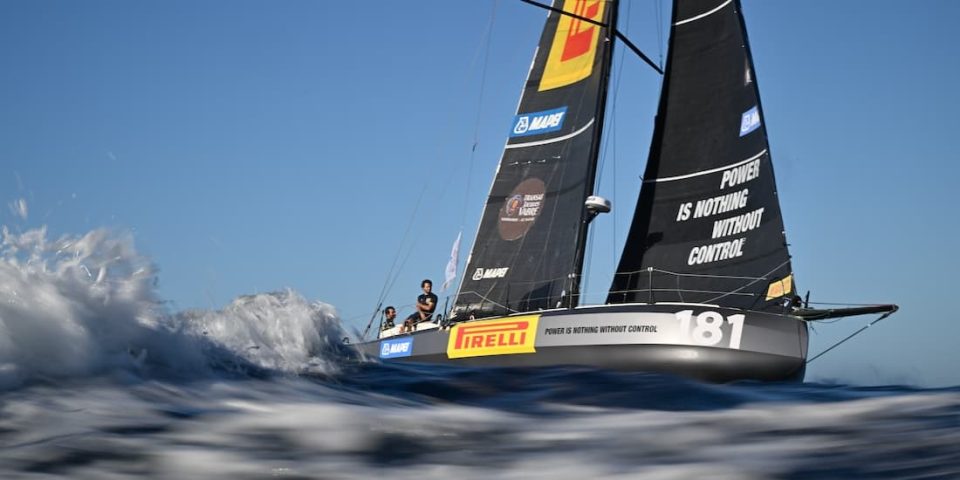Imoca: advantage to the Koch-Finot Conq designs
For their first season on the Imoca circuit, the Koch-Finot Conq designs made sensation by taking the top two places – For People (Thomas Ruyant / Morgan Lagravière) ahead of Paprec Arkéa (Yoann Richomme / Yann Eliès) – with the co-designer of both boats, Antoine Koch, taking third place with Sam Goodchild on For The Planet, the 2019 Verdier design (formerly LinkedOut on which he had also worked).All three had opted for the south option before Madeira, a wiser route with a fairly stable wind and less heavy seas, which led David de Prémorel, CEO of Finot Conq, to say: “The latest generation boats, whether Charal, For People or Paprec-Arkéa, have not encountered the conditions for which they were optimised, namely heavy seas, with hulls that are slimmer and more V-shaped than others, designed to slow down as little as possible in the waves. Despite this, we can see that a gap is starting to open up with the previous generation.”
This explains in particular the choice of a northerly route by Justine Mettraux and Julien Villion, 6th on Teamwork.net. “They took a different option from the new generation of boats, which operate a little faster,” confirms Quentin Lucet, architect at VPLP Design, who designed the former Charal. The figures speak for themselves: “On the course sailed, For People is averaging 19 knots and Paprec Arkéa 18.8 knots [in 2021, the winner, LinkedOut, on a different course however, finished with an actual average speed of 15.44 knots, editor’s note], that’s enormous! continues David de Prémorel. And in the trade winds, with winds of around 17-18 knots, the average speed is around 23 knots.”
The conditions on the southern route also enabled For The Planet to be very fast, as Antoine Koch points out: “Downwind, we were very fast on flat seas, but on the last two days of the race, when the sea state increased slightly, the atmosphere was completely different, both in terms of life on board and performance. Every time we found ourselves side by side with Paprec Arkéa, they were systematically going faster, by 1.5 to 2 knots.”
The battle for fourth place between two Manuard designs, Initiatives Coeur (Samantha Davies / Jack Bouttell) and Charal (Jérémie Beyou / Franck Cammas), was narrowly won by the latter, despite being deprived of his mast head zero (large gennaker) since the Canaries (see the interview with Franck Cammas above). Sam Manuard is nonetheless positive, observing that “Jérémie and Franck were fast upwind in slightly strong conditions and managed to make progress in using their small sail to overtake Initiatives Coeur“. He concluded: “The boats were pushedclose to 100%. It will be interesting to see what they’re capable of reproducing solo.” Let’s see during Retour à La Base, which sets off from Fort-de-France next Thursday.
At the end of a breathless suspense, it was finally, as in the Imoca class, the southern route that had the last word in Class40 and led Alla Grande Pirelli (Ambrogio Beccaria / Nicolas Andrieu) to victory on the second leg of the Transat Jacques Vabre (and overall), ahead of two boats of the northern option, Crédit Mutuel (Ian Lipinski / Antoine Carpentier) and Amarris (Achille Nebout / Gildas Mahé). The latter finished second overall – Crédit Mutuel had dismasted between Le Havre and Lorient – ahead of IBSA (Alberto Bona / Pablo Santurde).For Lionel Huetz, an engineer and doctor in hydrodynamics at Marc Lombard Yacht Design Group, who designed Lift V2 Amarris, “the race is quite difficult to analyse, because we saw boats that were very fast in their weak points and sometimes less so in their strong points. For example, we expected Alla Grande Pirelli to be superior downwind in the medium, but IBSA managed to keep up with us for a week.”
Gianluca Guelfi, the designer of the Musa 40 (Alla Grande Pirelli, Influence 2 and Acrobatica) adds: “The differences in performance between the boats are quite small. As the class is fairly limited, we can only make small changes to the hull shapes”. However, the Musa 40 has confirmed its versatility: “It has no holes and is never caught out by the others in terms of speed. Psychologically, it allows you to lead a race on the attack”, continues its Italian architect. Lionel Huetz adds: “They’ve also been very well prepared, and their sail plan in particular is extremely well developed. They don’t have a furler on the J1, and in strong winds, that’s an advantage because all the weight of the sail is on deck. We saw at the start that it made a difference.”
The engineer from Lombard, who was pleased to see Amarris finish second – “Despite Gildas Mahé’s injury in a crash in a wave a few days ago, they managed to overtake Influence 2 and were fast all the way to the finish” – also highlights “the incredible race by Crédit Mutuel, the oldest scow in the fleet (2019), which was re-masted just before the start”. This Raison design “is quite at ease when there are in heavy seas and strong winds, which partly explains why Ian and Antoine headed north to find the conditions for which the boat had been designed”, explains Erwan Tymen, project manager for the Pogo S4, a Verdier design built by Structures.
The Pogo S4s may not have finished on the podium, but they put up a good fight, with 4th and 6th place overall for Everial (Erwan Le Draoulec / Tanguy Leglatin) and Groupe Snef (Xavier Macaire / Pierre Leboucher), the latter having opted for an intermediate route 900 miles from the finish, only to find themselves trapped in the calms. “It’s obviously disappointing because they were in the lead for part of the race,“ says Erwan Tymen. “It was a challenging choice to opt for the northerly route when they had a very southerly position after the Canaries.”
Photo: Jean-Louis Carli / Alea






